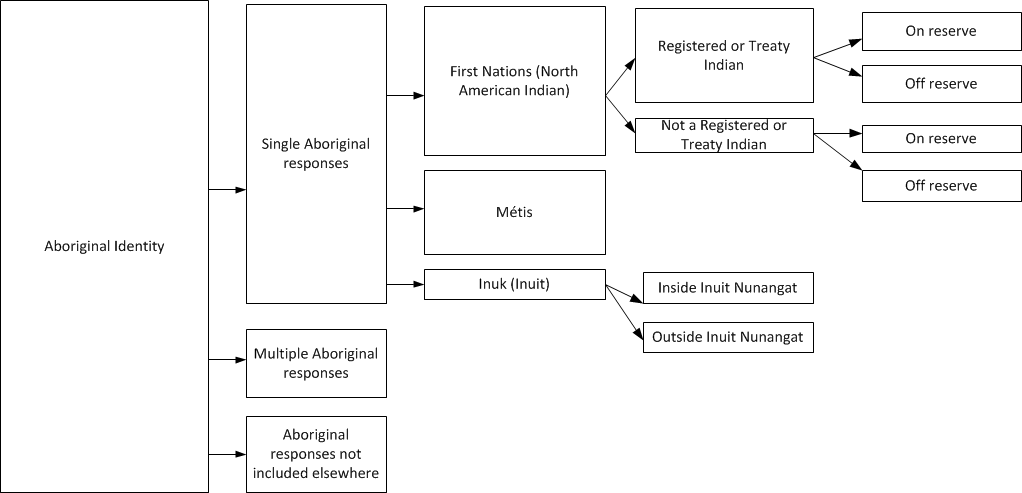Dictionary, Census of Population, 2016
Figure 5.3
Aboriginal identity population in the Census of Population

Source: Statistics Canada, Census of Population, 2016.
Description for Figure 5.3
This diagram shows the Aboriginal Identity concept and how it relates to other census variables. The Aboriginal Identity category is divided into three categories: Single Aboriginal responses; Multiple Aboriginal responses; and Aboriginal responses not included elsewhere. Single Aboriginal responses category is divided further into three subsequent categories: First Nations (North American Indian); Métis; and Inuk (Inuit).
First Nations (North American Indian) category can be divided into two categories: Registered or Treaty Indian and Not a Registered or Treaty Indian. Both of these two last categories can be further divided into two subsequent categories: On reserve and Off reserve.
Métis category is not subdivided based on the geography.
Inuk (Inuit) category can be divided into two categories: Inside Inuit Nunangat and Outside Inuit Nunangat.
Source: Statistics Canada, Census of Population, 2016.
Figure 5.3 shows some ways in which the Aboriginal identity population can be broken down using other census variables. The breakdown includes Registered or Treaty Indian status and two geographical variables ‒ Residence on or off reserve and Residence inside or outside Inuit Nunangat to examine the makeup of the Aboriginal identity population. It is important to note, however, that there are various ways to define the Aboriginal population using data from the 2016 Census depending on the focus and the requirements of the data user.
The Aboriginal identity population includes all people who indicated that they:
- are First Nations (North American Indian), Métis or Inuk (Inuit); and/or
- have Registered or Treaty Indian (that is, registered under the Indian Act) status; and/or
- have Membership in a First Nation or Indian band.
The Aboriginal identity population can be further divided based on whether a respondent is in one Aboriginal group only, in two or more Aboriginal groups, or not in an Aboriginal group but has Registered or Treaty Indian status and/or a membership in a First Nation/Indian band:
- Single Aboriginal response includes people who are First Nations (North American Indian), or Métis or Inuk (Inuit);
- Multiple Aboriginal responses include people who are any two or all three of: First Nations (North American Indian), Métis or Inuk (Inuit);
- Aboriginal responses not included elsewhere include people who are not First Nations (North American Indian), Métis or Inuk (Inuit), but have Registered or Treaty Indian status and/or that they were a member of a First Nation/Indian band.
Single Aboriginal responses can be further divided by geographic variables. In particular, the Inuit population can be further divided by Residence inside or outside Inuit Nunangat. The First Nations population can be further divided by Residence on or off reserve. The First Nations population can also be categorized by whether a respondent has or does not have Registered or Treaty Indian status.
- Date modified:
